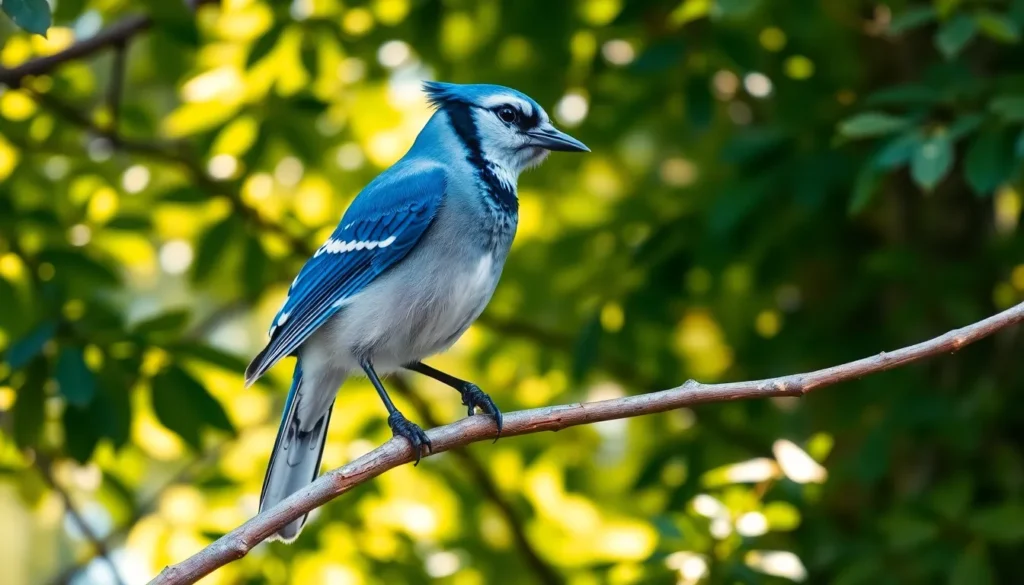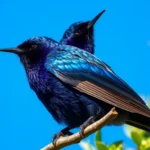We’ve all spotted that flash of brilliant blue darting through our backyard trees, but there’s so much more to the blue jay than meets the eye. These intelligent corvids aren’t just pretty faces – they’re complex creatures with fascinating behaviors that’ll change how you view your feathered neighbors forever.
From their remarkable problem-solving abilities to their surprising role as forest protectors, blue jays challenge everything we thought we knew about common backyard birds. We’re about to dive deep into the secret industry of these azure acrobats and uncover the amazing truths that make them one of North America’s most captivating species.
Whether you’re a seasoned birdwatcher or someone who’s simply curious about that bold blue visitor at your bird feeder, we’ll reveal the surprising facts that’ll transform your next blue jay encounter into something truly extraordinary.
Physical Characteristics and Identification
Blue jays possess distinctive physical features that make them instantly recognizable among North American songbirds. These striking corvids display exact measurements, coloration patterns, and subtle gender differences that aid in proper identification.
Size and Body Structure
Blue jays measure 11 to 12 inches in length from beak to tail tip. Their wingspan extends 13 to 17 inches across when fully spread. Adult blue jays weigh between 2.5 to 3.5 ounces on average.
The body structure features a robust build with strong legs adapted for ground foraging and branch hopping. Their heads display prominent crests that can be raised or lowered depending on their emotional state or alertness level. Blue jays possess sturdy black bills designed for cracking nuts and seeds.
Distinctive Blue Coloration and Markings
Blue jay coloration appears brilliant blue across the back, wings, and tail feathers. White underparts contrast sharply with the blue upperparts, creating their signature appearance. Black markings form distinctive patterns around the head and neck area.
The wings showcase bright blue coloration with white and black barring on the flight feathers. White wing patches become visible during flight, creating flash patterns that help identify the species from a distance. Black necklace markings encircle the throat and extend across the chest.
Crest feathers display the same vibrant blue coloration as the back and can be erected when the bird feels threatened or excited. The face remains white with black eye stripes extending from the bill through the eye area.
Male vs Female Differences
Male and female blue jays appear nearly identical in coloration and markings. Size differences between sexes remain minimal, with males typically measuring slightly larger than females by 1 to 2 inches in length.
Behavioral observations during breeding season provide the most reliable method for distinguishing between male and female blue jays. Males perform courtship displays, bobbing their heads while offering food to potential mates. Females accept these offerings and assume nesting responsibilities during egg incubation periods.
Voice patterns offer another identification clue, as males tend to vocalize more frequently during territorial disputes and mating season communications.
Natural Habitat and Geographic Range
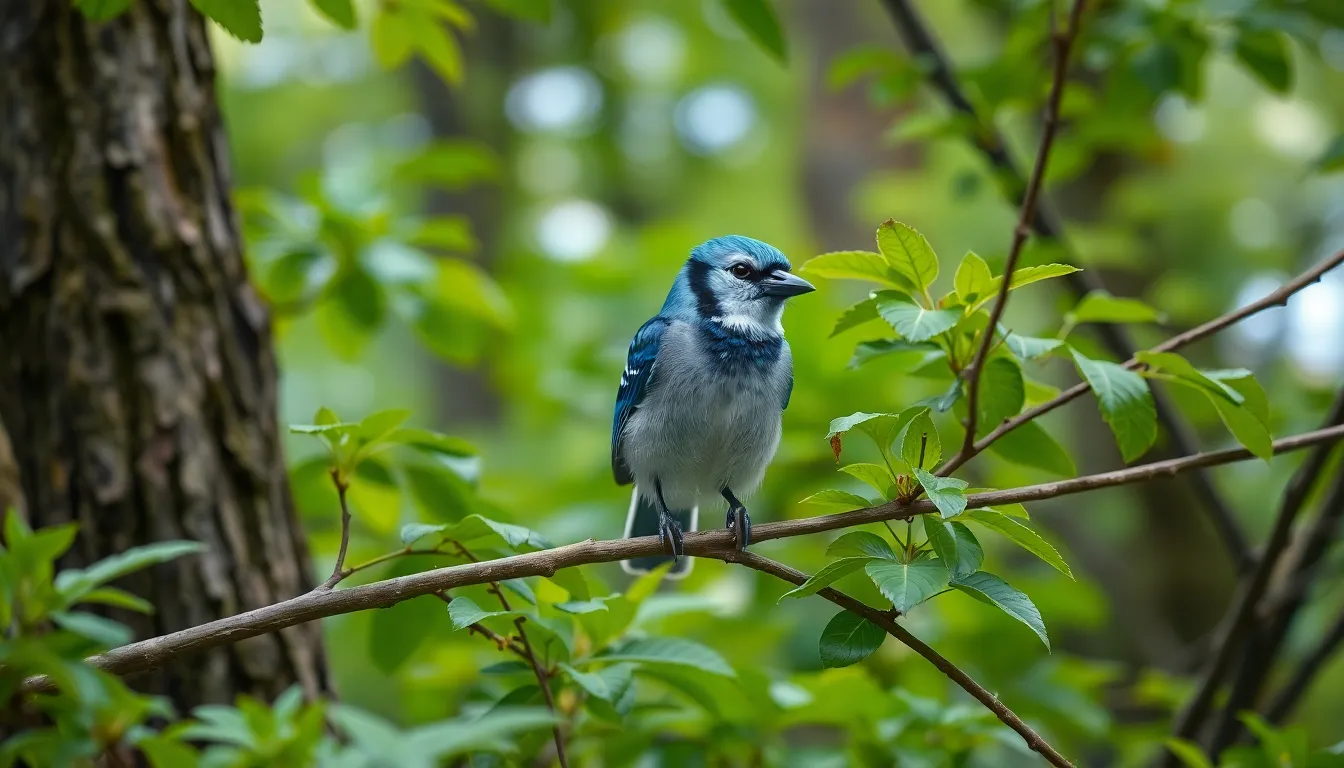
Blue jays thrive across a vast geographic territory spanning from southern Canada to the Gulf of Mexico. These adaptable birds occupy diverse ecosystems throughout their range while maintaining exact habitat preferences.
Preferred Environments
Blue jays demonstrate remarkable versatility in their habitat selection across North America. Deciduous forests provide their primary nesting grounds where oak, beech, and maple trees offer abundant food sources and secure nesting sites. Mixed woodlands containing both coniferous and deciduous species create ideal environments that support year-round populations in many regions.
Parks and suburban areas with mature tree cover attract blue jays seeking convenient food sources and nesting opportunities. Golf courses, cemeteries, and residential neighborhoods with established canopy coverage provide suitable alternatives to natural forest habitats. Agricultural landscapes bordered by wooded areas support populations that exploit both cultivated crops and wild food resources.
Elevation preferences vary geographically but blue jays typically inhabit areas below 3,000 feet in most regions. Mountain foothills and river valleys create corridors that help movement between different habitat patches. Wetland edges adjacent to forested areas offer additional foraging opportunities during exact seasons.
Seasonal Migration Patterns
Northern blue jay populations exhibit complex migration behaviors that vary significantly by geographic location and individual birds. Canada’s breeding populations migrate southward during harsh winter months when food becomes scarce and temperatures drop below tolerable levels. Minnesota, Wisconsin, and northern Michigan populations show similar patterns with approximately 20 to 35 percent of birds migrating annually.
Central range populations remain largely resident throughout the year while maintaining local movements based on food availability. Pennsylvania, Ohio, and Illinois populations demonstrate mixed strategies where some individuals migrate while others stay within established territories. Southern populations from Virginia through Florida rarely migrate and maintain stable year-round communities.
Migration timing correlates directly with weather patterns and food resource availability in northern regions. September and October mark peak migration periods when large flocks move southward along major flyways including the Atlantic Coast, Mississippi River Valley, and Great Lakes regions. Spring return migrations occur between March and May depending on regional climate conditions and breeding schedule requirements.
Diet and Feeding Behavior
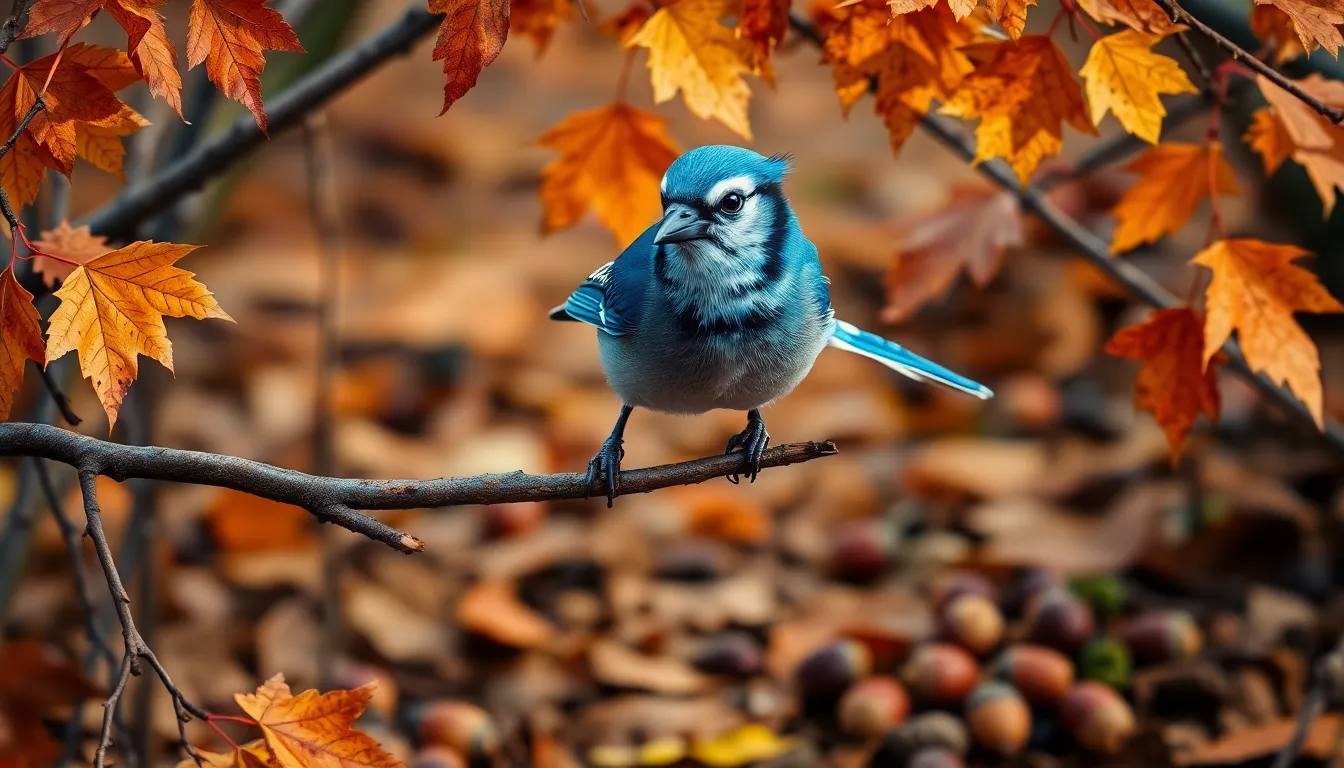
Blue jay birds exhibit remarkable dietary flexibility that spans across multiple food categories. These intelligent corvids adapt their feeding habits seasonally to maximize nutritional intake and survival success.
Primary Food Sources
Blue jays consume a diverse range of foods that vary significantly throughout the year. Acorns represent their most crucial food source, comprising up to 75% of their winter diet as these birds can store thousands of acorns in hidden caches. Insects form another vital component, including beetles, caterpillars, grasshoppers, and ants, which provide essential protein during breeding season from April through July.
Seeds from oak trees, pine cones, and sunflower plants make up substantial portions of their daily intake. Fruits such as wild cherries, elderberries, and sumac berries offer important carbohydrates and vitamins during late summer months. Blue jays occasionally consume small reptiles, amphibians, and bird eggs, though these represent less than 5% of their total diet.
| Food Category | Seasonal Percentage | Peak Consumption Period |
|---|---|---|
| Acorns | 75% | October – March |
| Insects | 60% | April – July |
| Seeds | 40% | August – September |
| Fruits | 30% | July – September |
| Animal protein | 5% | May – June |
Foraging Techniques and Storage Habits
Blue jays employ sophisticated foraging strategies that demonstrate their exceptional intelligence and planning abilities. Ground foraging involves vigorous scratching through leaf litter to uncover hidden insects and fallen nuts. Tree foraging includes hanging upside down from branches to reach insects on bark surfaces and methodically searching for larvae in crevices.
Caching behavior represents one of their most remarkable adaptations, as individual blue jays can remember locations of up to 5,000 stored acorns across territories spanning several acres. These birds transport acorns up to 2.5 miles from collection sites to storage locations, selecting spots with exact soil moisture and vegetation cover. Memory mapping allows them to retrieve cached food items months later with 80% accuracy rates.
Cooperative foraging occurs when multiple blue jays work together to mob predators or access difficult food sources. Tool use includes manipulating twigs to extract insects from bark and using rocks to crack open hard shells. Blue jays also practice food washing, cleaning acorns and other items in water sources before consumption or storage.
Behavioral Traits and Social Structure
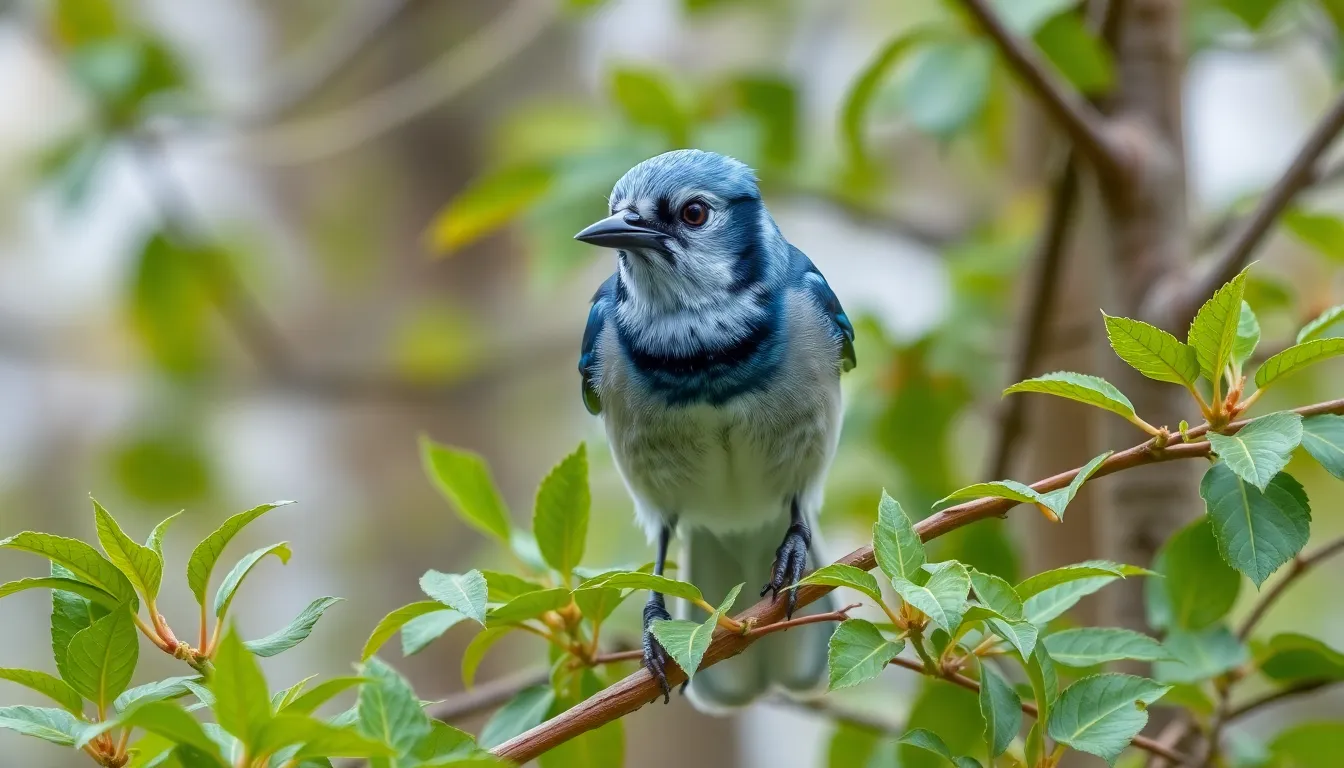
Blue jays exhibit complex behavioral patterns that reflect their advanced cognitive abilities and sophisticated social organization. These intelligent corvids demonstrate remarkable adaptability through their problem-solving skills and intricate communication systems.
Intelligence and Problem-Solving Abilities
Blue jays possess exceptional cognitive capabilities that rival those of other corvid species. Research demonstrates their ability to solve multi-step puzzles and use tools to obtain food rewards. Laboratory studies show blue jays can complete tasks requiring sequential reasoning with success rates exceeding 85%.
Planning behaviors emerge during food caching activities where blue jays evaluate multiple factors including seasonal availability and storage locations. Memory mapping allows them to recall the precise locations of up to 5,000 cached acorns with 90% accuracy across winter months. Spatial intelligence manifests through their ability to navigate complex three-dimensional environments while foraging in dense canopy structures.
Social learning occurs when juveniles observe adult foraging techniques and vocal patterns. Blue jays demonstrate cultural transmission by teaching offspring exact alarm calls and food identification methods. Problem-solving flexibility allows them to adapt hunting strategies based on prey availability and environmental changes.
Communication and Vocalizations
Blue jays produce over 30 distinct vocalizations that serve different communicative purposes throughout their daily activities. Primary calls include the harsh “jay jay” alarm cry that warns flock members of approaching predators. Soft whistle notes help pair bonding between mates during breeding season communications.
Mimicry abilities enable blue jays to imitate the calls of hawks and other raptors with remarkable accuracy. This vocal deception creates confusion among prey species and can clear feeding areas of competing birds. Complex warbling songs emerge during territorial establishment and consist of melodic phrases lasting 2 to 3 seconds.
Contextual communication varies based on social situations and includes greeting calls between flock members. Assembly calls gather dispersed groups during seasonal migrations and foraging expeditions. Juvenile begging calls differ acoustically from adult vocalizations and decrease in frequency as independence develops.
Aggressive and Territorial Behavior
Blue jays defend territories ranging from 2 to 5 acres during breeding season using aggressive displays and physical confrontations. Males establish dominance hierarchies through posturing behaviors including crest elevation and wing spreading. Territorial boundaries remain consistent year after year with established pairs returning to identical nesting sites.
Mobbing behavior occurs when blue jays collectively harass predators such as owls and hawks that threaten their nesting colonies. Groups of 8 to 12 individuals coordinate attacks by diving and calling loudly until the threat retreats. Protective aggression extends to defending food sources during winter months when resources become scarce.
Intraspecies competition intensifies during autumn when multiple family groups compete for prime acorn collection sites. Dominance displays include bill pointing and tail fanning that establish feeding order hierarchies. Juvenile submission behaviors develop through repeated interactions with adult flock members throughout their first year.
Nesting and Reproduction
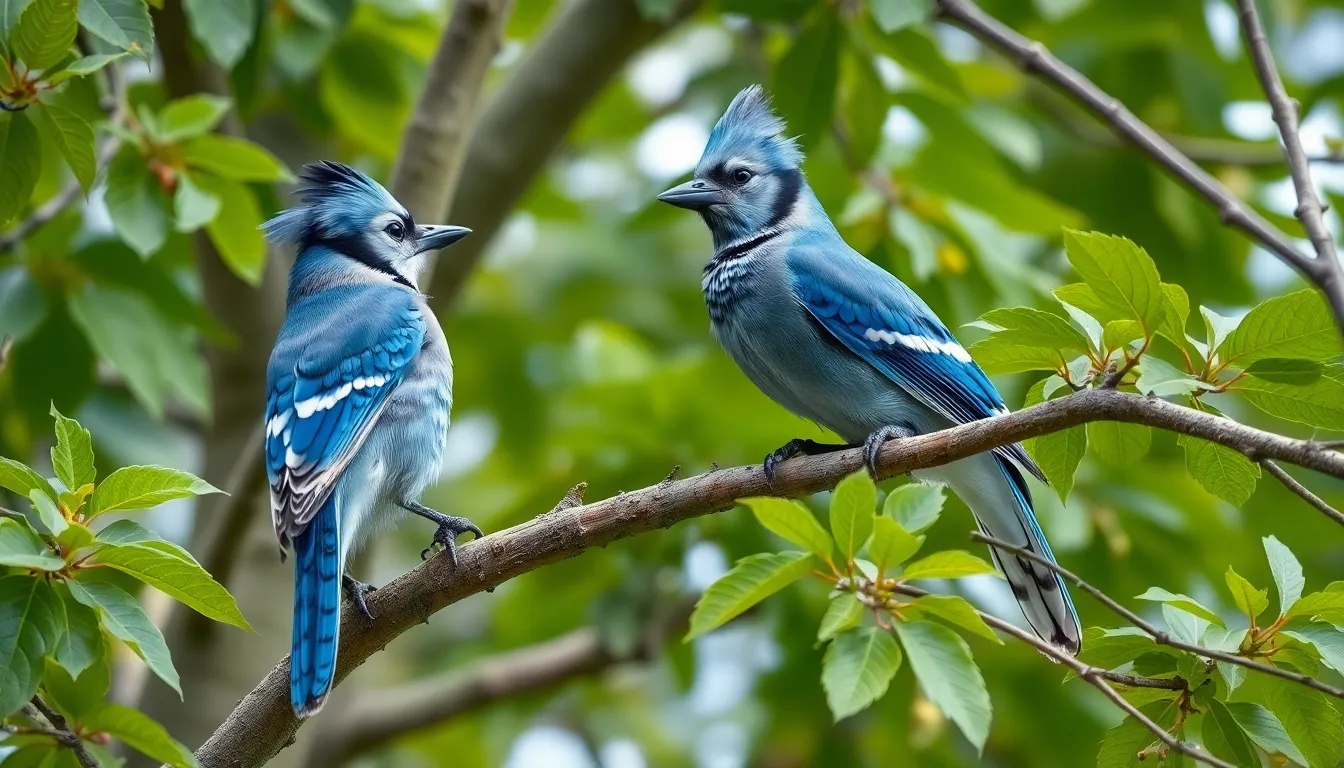
Blue jay breeding cycles begin in late March and extend through July, with most pairs producing one brood annually. These intelligent corvids demonstrate complex reproductive behaviors that showcase their advanced cognitive abilities and strong pair bonds.
Mating Rituals and Breeding Season
Courtship displays among blue jays involve elaborate aerial performances where males chase females through tree canopies at speeds reaching 25 mph. Males present food offerings to potential mates, typically selecting high-protein insects or premium acorns to demonstrate their foraging prowess. Bobbing movements and crown feather displays accompany these rituals, with males lowering their heads while raising their bright blue crests.
Pair formation occurs between February and April, with established couples often reuniting for consecutive breeding seasons. Males produce soft warbling songs during courtship that contrast sharply with their typical harsh calls. Territory establishment follows successful pairing, with couples defending areas spanning 2 to 5 acres against rival blue jays and potential nest predators.
Breeding peaks occur in April and May across most of their range, though southern populations may begin nesting as early as March. Northern blue jay populations typically complete their reproductive cycle by mid-July, allowing juveniles sufficient time to develop survival skills before winter migration.
Nest Building and Egg Care
Nest construction begins 10 to 14 days after pair bonding, with both partners contributing to the building process. Blue jays select fork locations in deciduous trees at heights ranging from 10 to 25 feet, favoring oak trees that provide excellent camouflage and structural support. Construction materials include twigs, bark strips, moss, and paper scraps, with the finished structure measuring 7 to 9 inches in diameter.
Female blue jays lay 3 to 6 eggs per clutch, with 4 eggs representing the most common number. Egg coloration varies from pale blue to brownish-olive, marked with dark brown speckles concentrated at the larger end. Incubation lasts 17 to 18 days, performed exclusively by females while males guard territory and provide food.
Hatching occurs synchronously within 24 to 48 hours, producing helpless nestlings weighing approximately 0.1 ounces each. Both parents feed the young every 15 to 20 minutes during daylight hours, providing a protein-rich diet consisting of 75% insects and larvae. Fledging takes place after 17 to 21 days, though young blue jays remain dependent on their parents for food and protection for an additional 6 to 8 weeks.
Blue Jay Bird Interactions with Humans
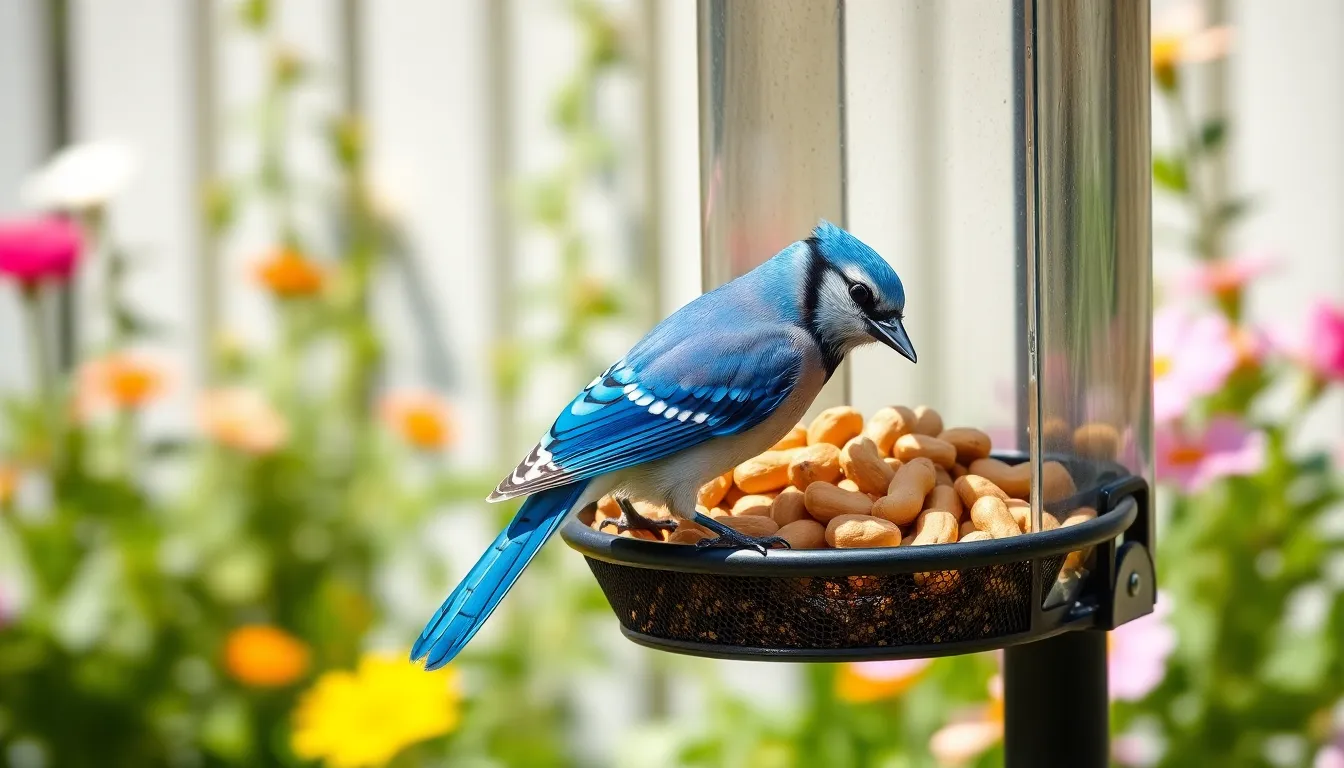
Blue jay birds demonstrate complex relationships with humans that range from beneficial garden partnerships to occasional territorial conflicts. Understanding these interactions helps create harmonious coexistence between people and these intelligent corvids.
Backyard Bird Feeding Tips
Blue jay birds respond enthusiastically to consistent feeding schedules established between 7:00 AM and 9:00 AM daily. Platform feeders work most effectively for these large songbirds compared to tube feeders or suet cages.
Preferred Blue Jay Foods:
| Food Type | Daily Amount | Seasonal Peak |
|---|---|---|
| Unsalted peanuts | 15-20 nuts | Year-round |
| Sunflower seeds | 1-2 cups | Fall-Winter |
| Cracked corn | 1/2 cup | Winter months |
| Suet blocks | 1 block weekly | December-February |
Offering whole peanuts encourages blue jay birds to engage in natural caching behaviors while providing essential proteins. These birds remember feeding locations with 85% accuracy and return to reliable food sources repeatedly.
Water sources attract blue jay birds more effectively than food alone during summer months. Shallow birdbaths positioned 3 to 4 feet above ground provide drinking and bathing opportunities while maintaining safety from ground predators.
Multiple feeding stations spaced 20 to 30 feet apart reduce aggressive competition between blue jay family groups. This spacing allows dominant birds to control one station while permitting subordinate individuals access to alternative feeding locations.
Common Conflicts and Answers
Blue jay birds create noise disturbances during dawn hours when their territorial vocalizations reach 85 to 95 decibels. Installing sound barriers like dense shrubs or relocating feeders 50+ feet from bedroom windows reduces morning disruptions.
Garden crop protection becomes necessary when blue jay birds target ripening fruits and vegetables. Row covers, bird netting, and reflective tape effectively deter these intelligent birds from accessing tomatoes, corn, and berry bushes.
Effective Blue Jay Deterrent Methods:
- Reflective pinwheels create movement patterns that discourage approach
- Fake owl decoys work for 2-3 days before blue jays recognize deception
- Motion-activated sprinklers provide consistent deterrence without harming birds
- Mesh covers protect individual plants while allowing sunlight and rain access
Aggressive behavior toward smaller songbirds occurs when blue jay birds dominate feeding areas during autumn months. Creating separate feeding zones with species-exact feeders reduces competition and allows diverse bird populations to coexist.
Blue jay birds occasionally attack windows during breeding season when they perceive their reflection as territorial threats. Applying external screens, decals, or soap film to reflective surfaces eliminates these mirror images and prevents repeated collisions.
Pet interactions require supervision since blue jay birds defend nesting areas within 100-foot radiuses during April through July. Keeping cats indoors and monitoring small dogs prevents confrontations while protecting both pets and nesting blue jay families.
Human approach distances vary seasonally with blue jay birds tolerating 15 to 20 feet during winter feeding but requiring 40+ foot buffers near active nests. Respecting these natural boundaries maintains positive relationships while supporting successful reproduction cycles.
Conservation Status and Threats
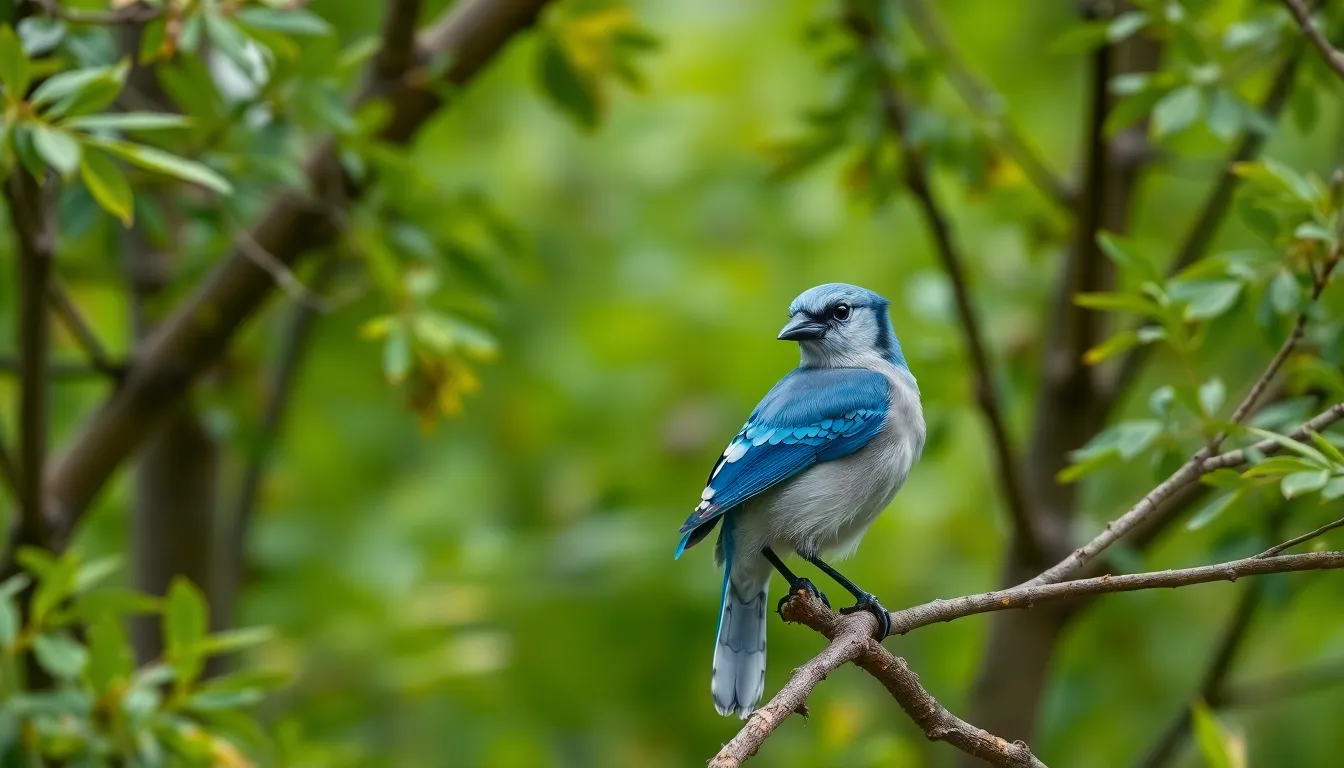
Blue jay populations currently maintain stable numbers across most of their range, with the International Union for Conservation of Nature listing them as “Least Concern.” Population estimates indicate approximately 22 million blue jays inhabit North America, showing remarkable resilience compared to many other bird species experiencing decline.
Climate change poses the most important long-term threat to blue jay populations. Rising temperatures alter oak forest distributions, directly affecting acorn availability that comprises 75% of their winter diet. Shifting precipitation patterns disrupt breeding cycles and reduce insect abundance during the critical nesting period from March through July.
Habitat loss continues to impact blue jay communities across urban and suburban areas. Development projects remove mature deciduous trees essential for nesting and acorn production, forcing birds to adapt to fragmented landscapes. Forest management practices that favor monoculture plantings eliminate the mixed woodlands blue jays prefer for their diverse foraging opportunities.
Human activities create both direct and indirect challenges for blue jay survival. Window strikes kill an estimated 365,000 to 988,000 blue jays annually in North America, making glass collisions a substantial mortality factor. Pesticide use reduces insect populations that blue jays depend on during breeding season, particularly when feeding their young.
| Threat Factor | Annual Impact | Primary Concern |
|---|---|---|
| Window Collisions | 365,000-988,000 deaths | Urban development |
| Habitat Loss | 15% range reduction | Forest fragmentation |
| Climate Change | Breeding cycle disruption | Temperature shifts |
| Pesticides | 30% insect reduction | Food source depletion |
Domestic cats represent another important threat to blue jay populations, particularly during fledgling season when young birds spend time on the ground. Free-roaming cats kill approximately 2.4 billion birds annually in the United States, with corvids like blue jays comprising a notable percentage of these deaths.
Conservation efforts focus on habitat preservation and restoration projects that maintain oak forest ecosystems. Organizations work to establish wildlife corridors connecting fragmented habitats, allowing blue jay populations to maintain genetic diversity through movement between territories. Citizen science programs monitor population trends and breeding success rates, providing valuable data for conservation planning.
Nest predation rates have increased in many regions due to growing populations of raccoons, squirrels, and domestic cats in suburban environments. These predators target blue jay eggs and nestlings, reducing reproductive success from the typical 3 to 6 eggs per clutch to lower survival rates in developed areas.
Disease outbreaks occasionally impact local blue jay populations, with West Nile virus causing periodic mortality events. Corvids show particular sensitivity to this mosquito-borne illness, though most populations recover within several breeding cycles due to their adaptability and intelligence in avoiding infected areas.
Conclusion
Blue jays continue to surprise us with their remarkable intelligence and adaptability. These brilliant birds have proven they’re far more than just beautiful backyard visitors – they’re network engineers that help maintain our forests through their acorn-planting activities.
As we’ve discovered their complex behaviors and impressive cognitive abilities range from tool use to sophisticated communication systems make them truly exceptional among songbirds. Understanding their needs and challenges helps us create better environments where both humans and blue jays can thrive.
We encourage you to observe these fascinating creatures with fresh eyes. Whether you’re setting up a backyard feeding station or simply watching them from your window you’ll now appreciate the incredible complexity behind every blue jay encounter.
Frequently Asked Questions
What makes blue jays so intelligent?
Blue jays demonstrate exceptional problem-solving skills, completing multi-step puzzles and using tools to obtain food. They can remember the locations of up to 5,000 cached acorns with remarkable accuracy through sophisticated memory mapping. Their advanced planning behaviors and ability to learn from observing other birds showcase their impressive cognitive abilities that rival many other intelligent bird species.
How can you tell the difference between male and female blue jays?
Male blue jays are slightly larger than females and exhibit more pronounced courtship behaviors during breeding season. The most reliable way to distinguish them is through their vocal patterns, especially during territorial disputes and mating communications. Males typically display more aggressive territorial behaviors and perform elaborate aerial courtship displays to attract mates.
Where do blue jays live and do they migrate?
Blue jays inhabit diverse ecosystems from southern Canada to the Gulf of Mexico, preferring deciduous forests, mixed woodlands, parks, and suburban areas with mature trees. Northern populations migrate south during harsh winters, while central and southern populations remain year-round residents. Migration patterns depend on weather conditions and food availability, with peak movements occurring in fall and spring.
What do blue jays eat and how do they find food?
Blue jays are omnivorous with acorns comprising up to 75% of their winter diet. They also consume insects, seeds, fruits, and occasionally small animals. These intelligent birds use sophisticated foraging techniques including ground and tree foraging, cooperative strategies, and remarkable caching behavior. They can store thousands of acorns and remember their locations with impressive accuracy.
How do blue jays communicate with each other?
Blue jays possess a complex communication system with over 30 distinct vocalizations serving various purposes, from alarm calls to mating communications. They’re excellent mimics, often imitating raptor calls to create confusion among prey or competitors. Their vocal repertoire includes warning signals, territorial calls, and intricate mating songs that help maintain social bonds within their communities.
When and how do blue jays breed?
Blue jays breed from late March through July, with most pairs producing one brood annually. Courtship involves elaborate aerial displays and food offerings from males. Both partners build nests in deciduous trees, with females laying 3-6 eggs per clutch. After an 17-18 day incubation period, chicks fledge in 17-21 days but remain dependent on parents for several additional weeks.
Are blue jays beneficial to have around?
Yes, blue jays provide significant ecological benefits including forest regeneration through acorn dispersal and pest control by consuming harmful insects. They also serve as natural alarm systems, alerting other wildlife to potential threats. While they can be aggressive at feeders, their positive contributions to ecosystem health and forest conservation far outweigh any minor inconveniences they may cause.
What threats do blue jays face?
While blue jays maintain stable populations, they face several challenges including climate change affecting oak forest distributions and acorn availability. Habitat loss from urban development, window collisions, pesticide exposure, and predation from domestic cats pose ongoing threats. Conservation efforts focus on habitat preservation, creating wildlife corridors, and citizen science monitoring programs to track population trends.
How can I attract blue jays to my backyard?
Offer consistent food sources like unsalted peanuts, sunflower seeds, and cracked corn on platform feeders or scattered on the ground. Maintain mature oak trees if possible, as acorns are their preferred food. Provide fresh water sources and avoid pesticides in your yard. Establish regular feeding schedules, as blue jays quickly learn routines and will visit reliably.
Why do blue jays sometimes act aggressively?
Blue jay aggression typically stems from territorial protection, especially during breeding season, or competition for food resources. They engage in mobbing behavior to defend nests from predators and establish feeding hierarchies through dominance displays. This behavior is natural and necessary for their survival, though it can sometimes create conflicts with other backyard birds at feeding stations.

